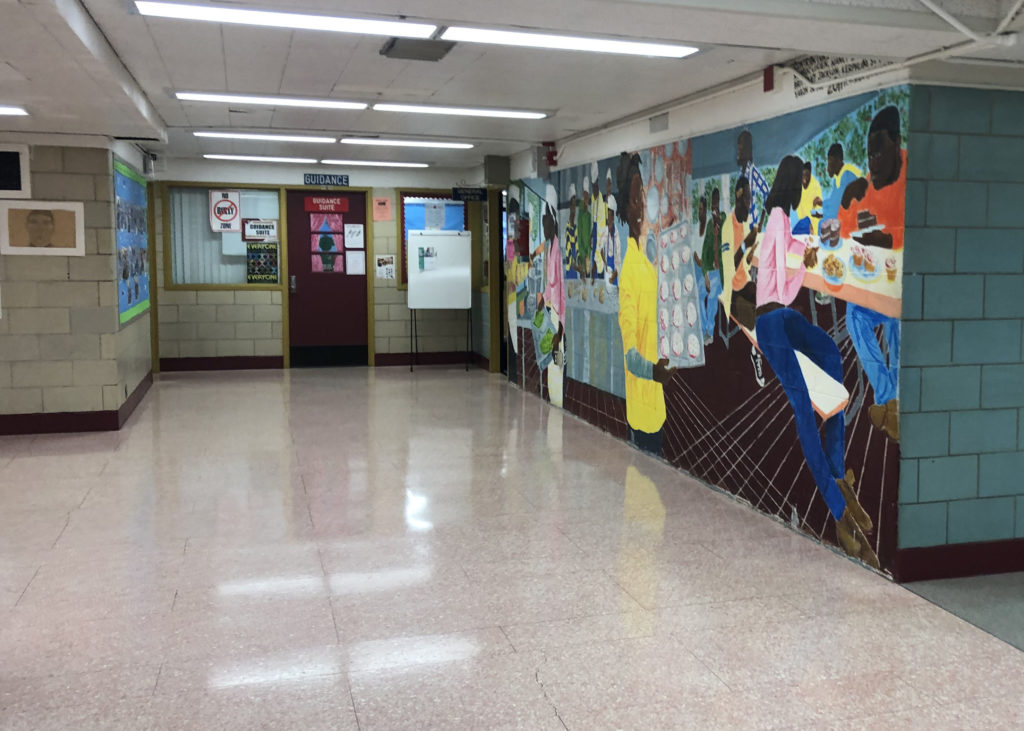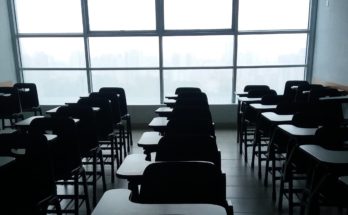
Photo Credit: Anya Schultz
Tucked away on the first floor of Brooklyn’s William E. Grady Career and Technical High School, past the metal detector, the light-filled atrium, and down the hallways painted with vibrant murals is the guidance suite. The sign outside says “no bully zone.”
Teenagers streamed into the tiny office for back-to-back meetings with social worker Keshia Jackson-Donatien one Wednesday in early March. Others sat on the bench outside her office.
“My part to play is really to make sure that students can function properly while in their classes,” said Jackson-Donatien, who has worked at the Brighton Beach vocational school for almost a decade.
Most of her time is spent in mandated counseling sessions for students with learning disabilities, which at Grady is 40 percent of the population, an unusually high percent for a general education school. The citywide average is 23 percent. Among neighboring Coney Island schools, it’s 20 percent.
But Grady only receives one part-time social worker for its 427 students, 80 percent of whom live in poverty. A full ten percent live in temporary housing, and half of the total population is chronically absent, often a warning signal of outside stress factors for students.
Principal Tarah Montalbano said her students require far more social and emotional support than the city provides. “Three academic counselors and a part time social worker is not going to cut it,” said Montalbano.
So, with a combination of budget juggling and several grants the principal sought on her own, Montalbano was able to temporarily staff her school with three full-time social workers, five part-time social workers, three guidance counselors, and a part-time college and career counselor.
The south end of the third floor has essentially been converted into the school’s therapy wing, complete with group therapy, individual counseling, a restorative justice coordinator, and a therapy dog.
“It’s doable, because we have so many other social workers in the building,” said Jackson-Donatien. “Prior to having all these other support services, it wasn’t.”
There’s an average of one social worker for every 735 students in New York City public schools, according to city data from the 2019-2020 academic year. The city employs 1,533 social workers to support its over 1.1 million students, 75 percent of whom are economically disadvantaged and 80,000 of whom are homeless. The National Association of Social Workers recommends a ratio of 250 to one.
“It’s clear that isn’t enough,” said David Bloomfield, an education professor at Brooklyn College and the CUNY Graduate Center. “I don’t think the Chancellor or the mayor or anybody else would say that’s a good ratio.”
The job of a social worker is to help students cope with life’s stresses, which have become particularly acute with the shutdown of schools to slow the spread of COVID-19. Access to education is now contingent upon access to the Internet, exacerbating a school system already plagued with inequality. Bloomfield said the social and emotional stresses of an online education will disproportionately impact low income families.
Despite recent state and citywide attention to mental health issues, advocates say little has happened to move the dial to help children in the schools. A state bill introduced last year to require a social worker in every school has stalled in the senate’s education committee.
“New York’s made a big deal about mental health reform, but it hasn’t really trickled down into the schools,” said Montalbano.
While the city reported hiring close to 200 new social workers this year, roughly 44 percent of all city schools still don’t have access to a social worker.
In Manhattan, where nearly 700 public schools have no have social workers, Borough President Gale Brewer asked the city’s Independent Budget Office to estimate the cost of staffing a full-time social worker in every school in the city. Its response came last year – it would cost the city around $95 million dollars.
A new citywide plan to place 85 new social workers in city schools funded with $10 million from First Lady Chirlane McCray’s Thrive NYC mental health initiative has yet to deliver on promises.
“I think she’s assigned to like fifteen different schools,” Montalbano said of the school mental health consultant assigned to Grady through the program. “So how much would she really do?”
Almost two decades ago, Grady had around 2,000 students packing the halls of the three-story building. But in 2003 with a graduation rate of 43 percent, Grady was targeted by the state as a school in need of improvement. Over the next decade, the threat of closure loomed overhead as Grady worked to meet the standards.
Montalbano, a former English teacher, became principal in 2013, and under her leadership the school’s graduation rate rose to 75 percent. But, as a result of the reputation as a failing school and city-wide initiative of school-choice, the school’s population changed dramatically. While the school struggled with enrollment, the number of students with learning disabilities increased from 25 percent in 2012 to 40 percent in 2018.
“Even though the overall number of students has dropped, the need has risen,” said Melanie Freedman, who became a school counselor at Grady 20 years ago when the school was four times as big.
Montalbano has taken it upon herself to seek statewide grants to support the mental health needs of her students. When Hurricane Sandy hit New York in 2012, Grady qualified for a recovery grant with Counseling in Schools, a non-profit that staffs school social workers. And when the initial grant expired two years ago, Montalbano applied again for a five-year grant. An additional state restorative justice grant funds a third full time social worker and a restorative justice coordinator.
“Because of our population, we’ve always been flagged and targeted for different types of grants that are out there,” Montalbano said.
Montalbano found extra money in the budget this year to try out a program to address chronic absenteeism. She chose The Leadership Program, a non-profit attendance intervention program approved by the city. Grady pays $57 thousand for two social workers and two social work interns who each work directly with around 10 students and their families.
But these funds have an expiration date. In two to three years both the Counseling in Schools and Restorative Justice grant are scheduled to end. The city so far has not offered any programs to fill the gap, a gap that Grady staffers believe is not nearly met even with the extra support they now receive.
Zeena Mine, a full-time social worker funded by the restorative justice grant, said for many students at Grady academics is not a priority because they’re dealing with outside challenges.
“I think part of the role of social worker in a school is to bridge that gap and offer them emotional support,” said Mine, who’s been at Grady for three years. “How a teacher offers academic learning, we offer emotional learning.”
On top of a filing cabinet in the back of Mine’s narrow third floor office is a plaque that reads, “I want every girl to know that her voice can change the world.” On the wall is a photo of Dr. Mae Jemison, the first black woman to travel in space.
Mine keeps a box of granola bars in her drawer in case a student didn’t eat breakfast. She also has a drawer full of condoms. “I’m not opposed to talk about anything,” said Mine. “I’m like, okay, let’s talk about sex. And they’re like ‘oh my god.’”
Mine spends her days calming down screaming teenagers, planning a school-wide events, or facilitating classroom restorative circles to build trust between students and teachers. Students come to her for coping strategies, or just to talk to an adult.
One morning in early March, a student walked into Mine’s office to ask to borrow a notepad and pen. Another came in and tried to balance a broomstick upright. A girl walked into the room and Mine noticed she was carrying a purse.
“You got a book bag,” exclaimed Mine. “Okay, okay!”
Mine said the student, like many of her classmates, has struggled with behavior and coming to class prepared. But she’s slowly improved her behavior and started to relate with more adults over the past two years.
“I can’t make her not a teenager,” said Mine. “But in terms of just being more confident in who she is, she’s come some way. She still has a long way to go, but she’s come some way.”
Schools are measured on metrics – graduation rates, attendance rates, test scores. It’s harder to measure social and emotional success. The ability to relate to adults, the decision to go speak to a counselor before getting in a fight, the capacity to bring a book bag to school.
In an ideal world, Freedman said the school would provide dorms for students, housing for their families, and access to outside healthcare and therapy. In other words, she wants for her students what more affluent students have.
Grady’s a school that strives to give its students everything they don’t have. Which is why Montalbano has made social and emotional support a high priority.
“Her thing is always helping the kid. It doesn’t matter who the kid is,” said Mine about Montalbano. “If a kid needs a coat, a kid needs money for a trip, she’s definitely that principal who is involved with the students. And I think that means a lot when the kids can know, let me just tell the principal. Let me just ask the principal.”
In an ideal world, Montalbano said she would want to social work department to look exactly how it looks now.
“But not me having to pay for it,” she added.



